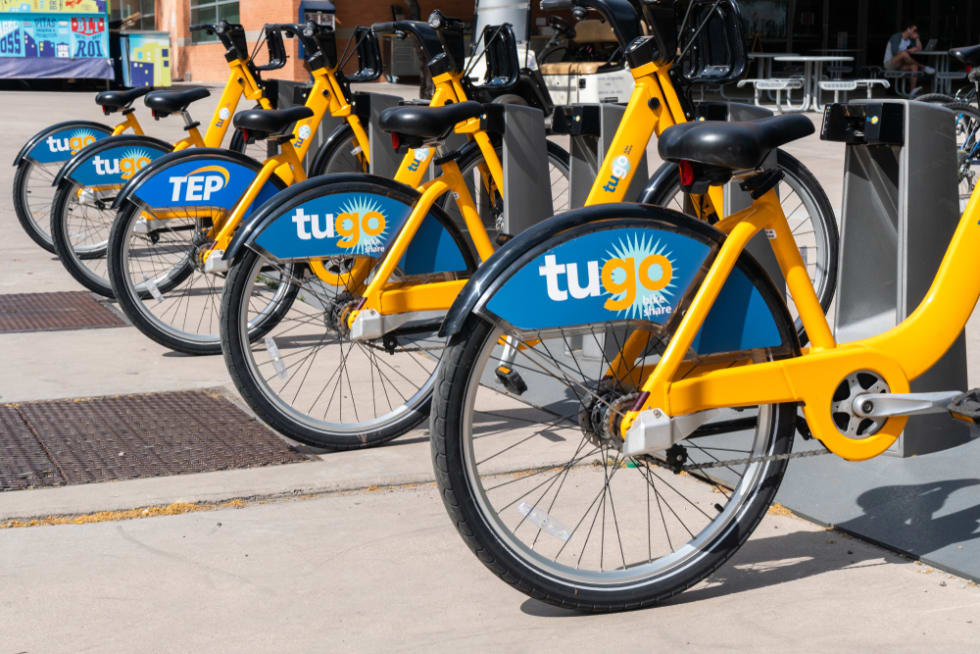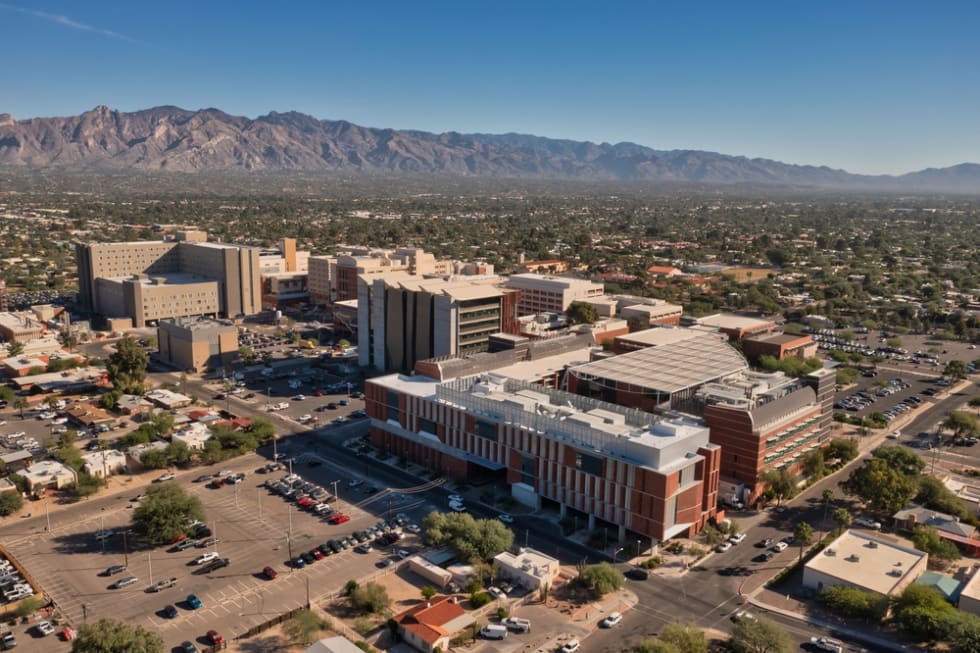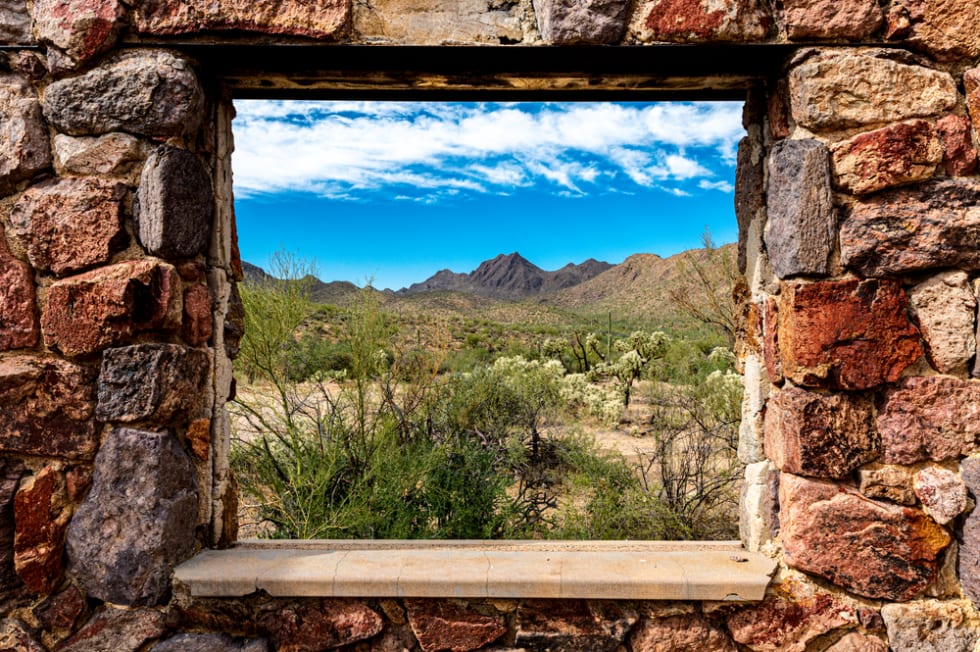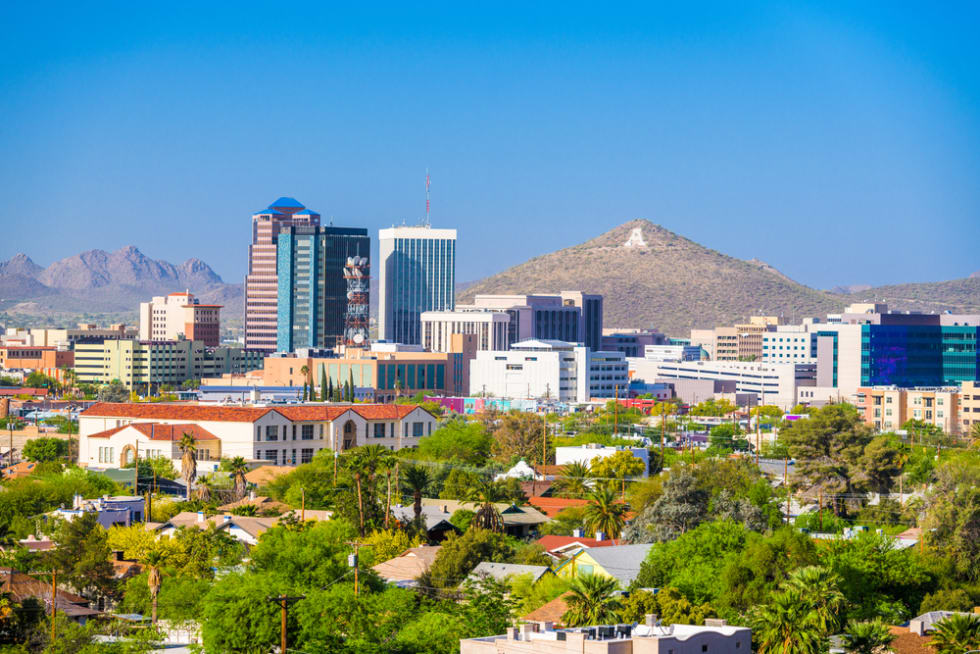RendezVous Urban Flats
- 11 units available
- Studio • 1 bed • 2 bed
- Amenities
In unit laundry, Patio / balcony, Hardwood floors, Dishwasher, Pet friendly, New construction + more

Tucson continues to attract new residents in 2025, thanks to its sunny climate, relatively low cost of living, and growing reputation as a hub for innovation, education, and outdoor living. Tucson blends affordability with access to culture and nature.
Tucson’s economy is fueled by sectors like aerospace and defense, education, and healthcare. Residents enjoy nearby access to national parks and mountain ranges, and a vibrant local arts and food scene.
Unlike high-cost metros such as Phoenix or Denver, Tucson offers significantly more affordable housing while still maintaining many of the amenities people look for in a mid-sized urban area. The average rent for a two-bedroom apartment in Tucson is $1,348 in 2025, compared to $1,820 in Phoenix.
In the sections below, we’ll explore the real cost of living in Tucson to help you decide if it aligns with your lifestyle and financial goals in 2025.
Note: We used internal Apartment List data to give you the most accurate snapshot of rents in Tucson as of October 2025. Other sources include Sperling’s BestPlaces, Numbeo, and the MIT Living Wage Calculator.
Tucson is more affordable than other similar U.S. cities. On average, it’s about 3.0% lower than the U.S. average and 8.8% lower than the Arizona average.
According to our latest data, areas like Miramonte have higher rents, around $1,831 for a two-bedroom apartment. On the other hand, neighborhoods like Dietz offer lower rents, averaging $1,066 for a two-bedroom.
| Cost of Living | Tucson | Arizona | U.S. |
|---|---|---|---|
| Overall | 97.0 | 106.4 | 100 |
| Grocery | 95.5 | 96.1 | 100 |
| Health | 85.4 | 97.3 | 100 |
| Housing | 93.2 | 119.7 | 100 |
| Median Home Cost | $303,400 | $407,400 | $338,100 |
| Utilities | 99.4 | 102.7 | 100 |
| Transportation | 96.6 | 107.0 | 100 |
| Miscellaneous | 98.6 | 93.7 | 100 |
Miramonte has the highest cost of living in Tucson, with one-bedrooms averaging $1,509 and two-bedroom rents averaging $1,831 per month, around the same as the Arizona average and national averages of $1,575 (one bedrooms) and $1,828 (two bedrooms).
Dietz is one of the most affordable places to live in Tucson, with one-bedroom rents averaging $829 per month and two-bedrooms at $1,066.
As of October 2025, the overall median rent in Tucson is $1,048, based on Apartment List data. The one-bedroom median rent is $874, while two-bedroom apartments are $1,122.
For Tucson:
| Bedroom | Median Price |
|---|---|
| Overall | $1,048 |
| One Bedroom | $874 |
| Two Bedrooms | $1,122 |
Other major cities:
| City | Median One-Bedroom Rent | Median Two-Bedroom Rent |
|---|---|---|
| San Diego | $1,963 | $2,460 |
| Phoenix | $1,109 | $1,322 |
| Scottsdale | $1,433 | $1,686 |
As of October 2025, the average for a one-bedroom apartment in Tucson is $1,052. Prices differ by neighborhood.
South Park apartments fall around $1,467, while areas like Dietz are much more affordable at around $829 per month. Rent can fluctuate depending on area, amenities, and the age of the building.
| Area | Average One-Bedroom Rent |
|---|---|
| Miramonte | $1,509 |
| Dietz | $829 |
| South Park | $1,467 |
| Tucson (overall) | $1,052 |
The average for a two-bedroom apartment in Tucson is $1,348 as of October 2025.
The final cost depends on factors like location, unit size, and amenities.
| Area | Average Two-Bedroom Rent |
|---|---|
| Miramonte | $1,831 |
| Dietz | $1,066 |
| South Park | $1,356 |
| Tucson(overall) | $1,348 |
The median home sale price in Tucson is around $340,000. That’s lower than the national median of $439,894.
With ongoing growth and more manageable home price increases compared to larger metro areas, Tucson remains an attractive option for buyers who are priced out of markets like Phoenix or Denver.
A common rule of thumb for housing affordability is the 30% rule, meaning you should spend no more than 30% of your gross income on rent. Based on the median one-bedroom rent of $874 in Tucson, you’d need to earn at least $34,960 per year, or $2,913 per month, to stay within the 30% income rule. That breaks down to about $16.81 per hour for a full-time worker. If you’re targeting a two-bedroom at the median $1,122, the required income jumps to $44,880 per year.
According to the U.S. Census Bureau, Tucson’s median household income is $60,483. That is lower than the national median of $81,604.
Keep in mind that rent is only one piece of your total cost of living. Day-to-day expenses like groceries, utilities, transportation, and healthcare can add up quickly. To better understand what fits within your budget, tools like the Apartment List Rent Calculator can help you find housing that aligns with your income.
For a more detailed look at local living costs, the MIT Living Wage Calculator estimates that a single adult living in Tucson (without children) needs to earn at least $20.85 per hour to cover basic necessities like housing, food, and medical care—just enough to get by without falling below the poverty line. This estimate doesn’t factor in savings, debt repayment, or discretionary spending like travel or entertainment.

The MIT Living Wage Calculator data breaks down typical car-based transportation expenses for different household types in the Tucson region.
| Household Type | Annual Transportation Cost | Monthly Breakdown |
|---|---|---|
| Single adult (no children) | $9,045 | $753.75 |
| Dual-income household, two children | $15,172 | $1,264.33 |
Tucson is largely a car-dependent city. While public transit is available, service can be limited in frequency and doesn’t always reach outlying neighborhoods efficiently. Much of the city is spread out, and walkability is generally limited outside of the downtown and university areas.
Major roads like Speedway Boulevard, Grant Road, and I-10 can experience slowdowns during peak commute times, so driving remains the primary and most practical way for most residents to get around Tucson and its surrounding communities.
In terms of walkability, Walk Score data highlights Tucson neighborhoods where you can go car-free:
These neighborhoods offer the most convenience for those who depend on public transportation or choose to live without a car.
According to the MIT Living Wage Calculator, a single adult without children in the Tucson area spends at least $4,085 per year on food, while a two-adult household with two children averages $11,974 annually. That breaks down to about $340.42 per month for a solo renter and $982.83 monthly for a four-person family, covering groceries and basic meals at home.
Dining out in Tucson can be relatively affordable. According to Numbeo, an average meal at an inexpensive restaurant costs around $19.00, while a three-course dinner for two at a midrange spot averages around $75.00.
Regularly dining out or ordering takeout can significantly increase your monthly food expenses.
Child care is a notable expense for families living in the Tucson area. According to MIT Living Wage data for Tucson, child care costs for one child average $10,406 per year. For two children, annual child care costs more than double to around $20,812.
That breaks down to around $867 monthly for one child, and $1,734 per month for two. These costs play a major role in shaping the living wage required for parents and are essential to consider when planning a family budget.
Since child care is often one of the highest expenses for households, many families look for ways to ease the financial strain. This might involve shifting work hours to accommodate remote or flexible schedules, looking for more budget-friendly child care providers in other neighborhoods, or arranging shared caregiving with trusted family members or close friends.

Using data from the MIT Living Wage Calculator, a single adult without children typically spends around $2,549 per year on healthcare, including insurance premiums and out-of-pocket costs. For a family of two working adults and two children, healthcare expenses rise to approximately $8,654 annually.
A 915-square-foot Tucson apartment has average monthly utility costs (electricity, heating and cooling, water, garbage) of $258.73, which is about 23% higher than the national average of $210.15.
On top of that, a mobile phone plan (10 GB plus voice) averages $78.31 per month, while high-speed internet (60 Mbps or more, unlimited data) runs about $83.95 per month, bringing the overall monthly total to $420.99.
Tucson is known for its hot desert climate, with long, dry summers and average high temperatures regularly climbing into the upper 90s and often surpassing 105°F during peak heat. The summer heat can feel especially relentless in June through August. Residents should be prepared for higher electricity bills during this time of year, as air conditioning becomes essential for staying comfortable and safe.

Tucson provides residents with a wide range of affordable options to stay active and enjoy local culture—from scenic desert hikes and public parks to community events, museums, and live music.
Tucson is known for its beautiful desert landscapes and abundant outdoor recreation. Reid Park is a popular spot, offering walking and biking paths, duck ponds, playgrounds, sports fields, and the Reid Park Zoo.
Nature enthusiasts can also explore Sabino Canyon Recreation Area in the Coronado National Forest, which features desert hiking trails, waterfalls during the monsoon season, and a tram for easy exploration.
According to Numbeo, the average monthly fitness club fee in Tucson is about $35.81 per person. This is lower than the national average.
For even more affordable options, Tucson Parks and Recreation has more than 20 recreation centers across the city. These offer low-cost group fitness classes, access to public pools, weight rooms, and sports leagues for both youth and adults.
Tucson’s vibrant cultural scene blends Southwestern heritage with local arts, live music, and seasonal festivals.
Residents can enjoy First Thursday free admission nights at the Tucson Museum of Art, and community movie nights and concerts at Mercado San Agustín. The popular Tucson Meet Yourself Festival celebrates the city’s diverse cultures with free performances, dance, and food vendors.
The Arizona-Sonora Desert Museum is another regional favorite, featuring a zoo botanical garden, and natural history museum.

Tucson’s combined sales tax rate is currently 8.7%, which includes Arizona’s 5.6% state sales tax, Pima County’s tax, and additional city-level taxes applied within Tucson. While this rate is moderate compared to some larger cities, it still adds up on everyday purchases and should be factored into your budget.
Arizona has a state income tax ranging from 2.59% to 4.5%, depending on income level. This is generally lower than in high-tax states like California, making Arizona more attractive to some professionals and retirees seeking tax relief.
Property taxes in Pima County (where Tucson is located) have an average effective rate of about 0.76%, which is slightly below the national average. While home prices in Tucson are more affordable than in many U.S. cities, property taxes are still a meaningful part of the overall housing cost. Renters may also feel the indirect impact, as rising property taxes can contribute to rent increases over time.
While Arizona’s overall tax burden is lighter than in some other states, it’s still important to consider the full picture when considering the true cost of living in Tucson.
Tucson plays a crucial role in Southern Arizona’s economy, supported by consistent job growth and a well-rounded mix of industries. Major sectors include aerospace and defense, healthcare, higher education, and solar energy.
In August 2025, Tucson’s unemployment rate was 4.8%, slightly above the California rate (4.1%) and the national rate (4.3%). The area’s average hourly wage was $25.36, below the state average ($30.31) and national average ($28.16).
Tucson’s expanding job market and affordable cost of living makes it an attractive option for students, families, and working professionals alike.
Whether you want to live near the University of Arizona, be close to major employers, or enjoy easy access to hiking trails, local coffee shops, and arts districts, Tucson offers a range of housing options to fit different needs and budgets.
Thinking about making a move? Start with the Apartment List quiz — it only takes a few minutes and helps match you with rental listings that align with your budget, commute, and lifestyle preferences, making your search faster and easier.
As of October 2025, the median rent for all apartment sizes in Tucson is $1,048 per month, with one-bedroom units at a median of $874 and two-bedroom units at $1,122.
One-bedroom apartments in neighborhoods like Dietz are notably more affordable, with one-bedroom rents averaging $829 per month and two-bedrooms at $1,066.
Using the most affordable rent example of $829 per month and adding estimated annual costs for food ($4,085), transportation ($9,045), utilities ($420.99), and healthcare ($2,549) for a single adult without children, total annual essential living expenses fall around $16,928.99. This does not account for savings, debt repayment, or discretionary spending.
As of the latest census, Tucson has a population of approximately 542,629 people, making it the second-largest city in Arizona.
Based on the 30% rent rule, a median one-bedroom rent of $874 requires a gross annual income of around $34,960 per year, or $16.81 per hour for full-time work.
The MIT Living Wage Calculator estimates a living wage as a single adult without children at $20.85 per hour to remain above the poverty threshold.
The U.S. Census Bureau estimates Tucson’s median household income at $60,483.


In unit laundry, Patio / balcony, Hardwood floors, Dishwasher, Pet friendly, New construction + more
In unit laundry, Patio / balcony, Hardwood floors, Pet friendly, All utils included, Garage + more